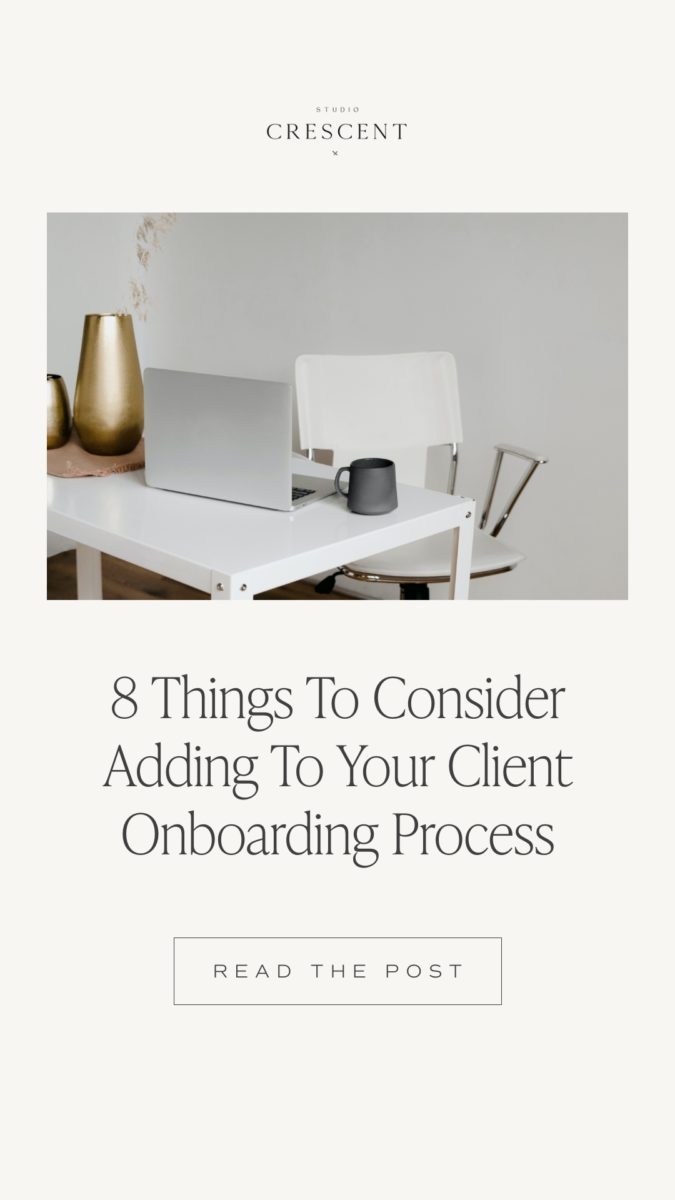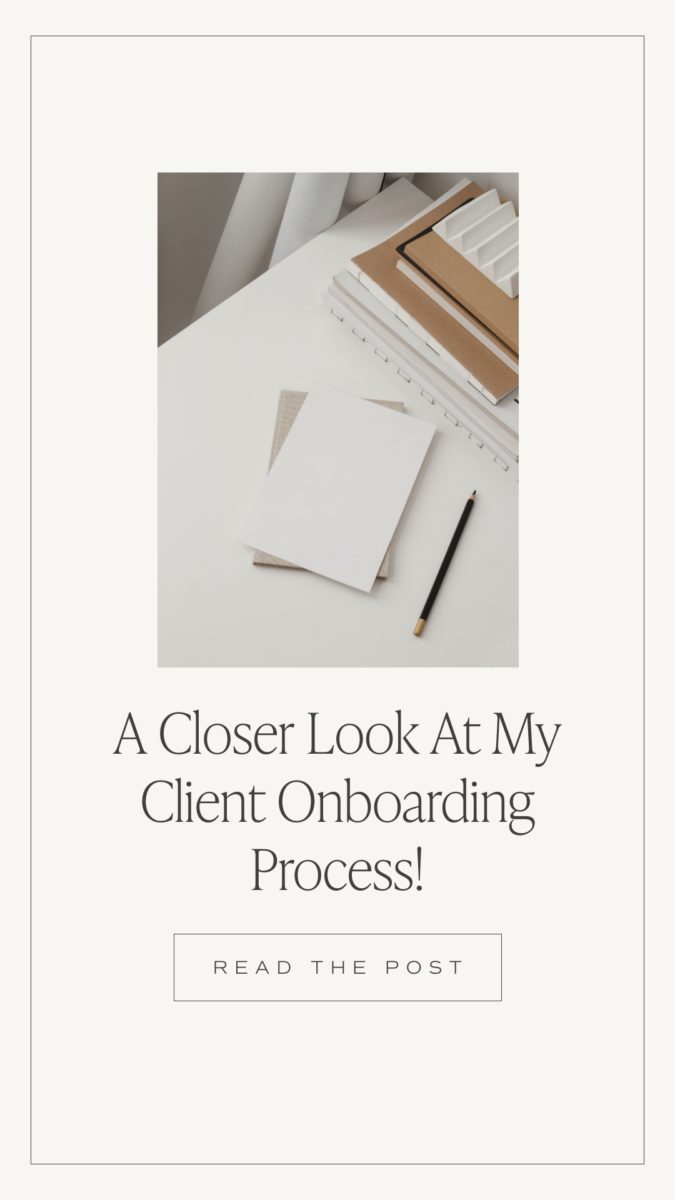8 Things to Include in Your Client Onboarding Process
In a previous post, I chatted about three reasons why it is more important than ever to have a client onboarding process as a service provider. Well, actually, I would even argue it is a must if you are really looking to serve your clients in the best and most stress-free way possible. A client experience goes beyond a discovery call and coffee gift card, it is anticipating your client’s needs throughout your time together and serves as an integral part of your brand’s touchpoints.
But Jess…That’s all great and all… what exactly is included in an onboarding process to ensure it is seamless, stress-free, and efficient?
Another great question!
While I am a brand and web designer by trade, this internal process I am sharing for my business is actually transferrable for any online business owner. So, grab your favorite notebook and a pencil, and let’s dive into it.

2-In-1 Client Application Form
This one may seem obvious to some but the first step of your client onboarding process actually goes beyond a contact form. Back in the day when it was sufficient to have a client fill out a contact form, in today’s day and age, there is a high chance that your lead is reaching out to 4-5 other service providers at the same time as they are reaching out to you.
Rather than have them fill out the form then wait a period of time to have you respond to them with a scheduling link… combine the two so that it is seamless and efficient for your lead. Platforms such as Calendly, Acuity, Honeybook or Dubsado allow you to combine your contact form with a calendar scheduler. That way, your lead will receive a meeting confirmation link right after they hit “submit” and you will have a better understanding of what they are looking for right in your inbox. Not to mention, this also helps in pre-qualifying them as a lead so that you don’t have to waste precious time on your discovery call asking about their business.
It’s a win-win for everyone!
Here are example questions you could include in your client application form to help pre-qualify your leads:
- What are your business goals for the next 6 months?
- What are you currently struggling with your business right now?
- What is the biggest challenge you face when it comes to your (service they are looking for)?
Value-Based Discovery Call
A discovery call is a chance for both you and the lead to get to know each other better to see if you are the right fit. Generally speaking, you will have had the chance to review their answers from the client application form above but also doing some basic research from their website or social media. My discovery call is usually no more than 30 minutes as that is sufficient time to get to know one another and answer any questions they may have.
Don’t worry so much about “selling” your services and going over what each package entails line-by-line. Instead, take this opportunity to have a conversation, listen to their needs, and chat about the value you can bring as a service provider. Once you have a chance to learn more about their needs, answer any questions they may have about your process, experience, and the transformation they could have by working with you.
Some valued-based questions could be:
- How does working with me / choosing this (service) impact your business as a whole?
- What does success or growth look like to you?
- Why would you like to work with me specifically?
Don’t SHY away from talking about pricing. Giving them a ball-park is a great way to let them know what to expect so they aren’t shocked after the call. Once you have a chance to give an estimate, let them know you will be working on a proposal and that you also would like to schedule a follow-up call with them to chat details.
Project Proposal & Follow Up Call
Once you are able to gather more information regarding their needs, it’s time to put together a proposal. This is also a great opportunity to showcase a little bit more about your business and how you operate with client projects.
What I personally like to do is to provide 2-3 pricing options after my discovery call so that they are able to visualize what each customized package will entail. It’s also a great way to include some of your add-on services that your client might have never even thought about! This shows that you are forward-thinking and truly caring about their business holistically and not just the task at hand. During this step, I sometimes also have a form at the end of the proposal for them to fill out should they wish to move forward with my services which includes a response deadline. This will prevent further back-and-forth emails and I can simply gather all of my answers all at once.
For example:
- Which package would they like to move forward with?
- Are they satisfied with the payment schedule? If not, what would be their preferred timeframe?
- Is there any upcoming events or vacations I should be aware of that could interfere with the project timeline?
- What is their mailing address?
- What is their go-to coffee order?
Want to add a personal touch? Record a video of you explaining the proposal so that they are able to better understand everything that you have mentioned. Don’t forget to schedule a follow up call so you can go over any questions they have. Don’t leave them hanging!
Contract & Invoice
After they have selected a direction to go with, get everything in writing to confirm all project details. It is important to emphasize that their project is NOT confirmed in your calendar until they have returned a signed copy of their contract as well as a non-refundable deposit.
A contract is absolutely necessary for any and every project so please don’t skim out on investing in a good contract. This serves as a binding document that lays out clear expectations on both ends so that we are both equally protected. This way, no one can claim misunderstandings down the line should an expectation not be met
I suggest reaching out to a small business lawyer in your local area! Otherwise, I invested in my contracts from The Contract Shop – as the contracts have been written and proofed by a professional lawyer. If you are interested, here is my referral link: Contracts For Small Businesses.
With a contract also comes an invoice! Don’t just request money from Paypal or Venmo left, right, and center without using an actual invoicing platform. Signing up for an accounting platform such as Wave or Quickbooks will save you many headaches down the road when tax season comes. It will automatically track your finances for you once it is all set-up, allow various payment options for your clients to use, as well as even send them automatic receipts. Depending on the platform you use, you can even include some of your branded elements on the invoices. Remember, you are running a business here! So don’t skim out on these little details!
Welcome Email & Guide:
Now that the paperwork is all complete, it’s time to welcome your client on board! I personally like to create a Welcome Guide for my client to refer to throughout our time together. That way, we can avoid going back and forth via emails for weeks to end. By anticipating their needs in advance, I am able to get some peace in mind that my client is being taken care of.
Here are some items I include with my Welcome guide:
- Welcome message
- Project Goals & Outcome
- Project Scope & Timeline
- My One-Of-A-Kind Process
- Clients’ Role & Responsibilities
- Overview of Platforms & Tools
- Office Hours & Communication Protocols
- FAQs
- Next Step to Take
As an added bonus, take this opportunity to send a welcome gift to your client or a handwritten note. It will make a whole world of a difference letting them know how thrilled you are to be working with them.

Project Management Tool
One of my favorite ways to manage projects and communicate with clients is through a project management platform. It’s an effective and collaborative tool to manage due dates on both sides and keep each other informed at all phases of the project.
I personally use Asana to manage my client projects and it has been a game-changer! In my welcome guide, I encourage all of my clients to keep their feedback and communication under each task in Asana so that we can ensure all messages are in one thread and not scattered throughout different platforms (i.e. email, IG messaging, text, etc.). Did I also mention that it is free? Yep – Asana’s free personal plan has more than enough features to get you started.
Other tools that are also reputable and similar are:
- ClickUp
- Trello
- Notion
- AirTable
Detailed Project Questionnaire
Last but not least, I assign a detailed project questionnaire for them to work on prior to our 1:1 strategy call together. This questionnaire has been strategically designed to help get them thinking about their business so that we are somewhat on the same page as we begin to dive deeper. This will look different for everyone depending on what business you run. For me as a brand and web designer, some of the questions that are on my questionnaire include:
- What’s your business? How is this significant to your story and what you do now?
- How do you want your audience to feel when they are interacting with your brand?
- What do you want your new branding and/or website to accomplish?
- What’s one of the best compliments you have received about working with you?

Onboarding is a beast of its own but it is SO worth the time to do it right the first time. You can always go back and tweak little changes afterward but having a solid process and foundation to rely on will set you apart from your competitors.
BTW – If you are a new-ish business owner, I totally get that bootstrapping is the best way to go and utilizing multiple platforms to get what you need. There is no shame in that until you are at a more comfortable place with clients before investing in a full CRM platform. Here are some of the tools and platforms I have mixed and matched with during the client onboarding process:
- Hello Sign for Contracts
- Calendly for Scheduling with integration to Zoom or Google Hangouts
- Waves Accounting for Proposals and Invoices
- Asana for Project Management
If you are looking to invest in a CRM tool to help automate and streamline your client onboarding process, here are a few reputable tools to look into that fit your needs:
Feel free to take a peek at my resources page to see all the tools I use to run my business! It truly takes a village.
Do you have all of these steps for your client onboarding process? Let me know where you are and if you have any questions!
LIKE THIS POST? SHARE & PIN THIS POST!
Shop Showit Website Templates
Someday
Editorial, Edgy, Minimal
View demo
Joelle
Artistic, Striking, Refined
View demo
Adrienne
Modern, Fresh, Cool
View demo
code-free • stylish • SEO optimized
Designed By Yours Truly 🤍

